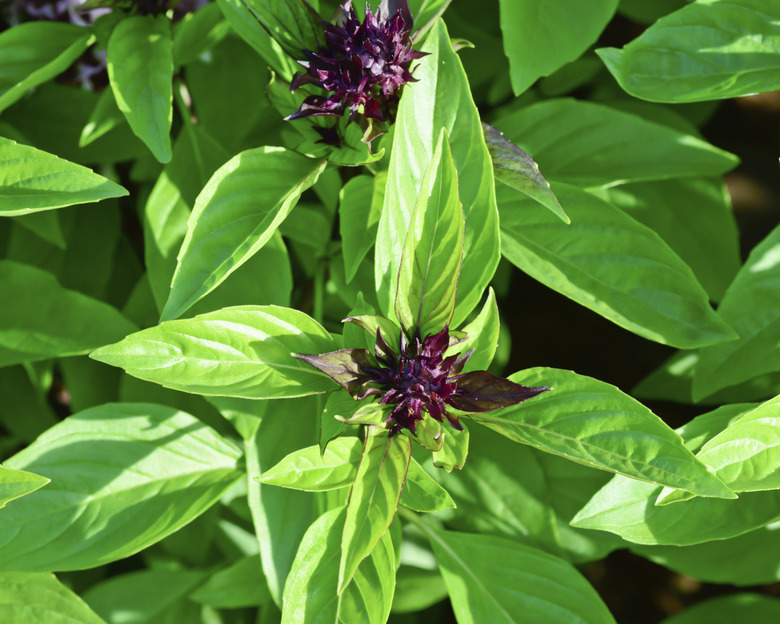How To Grow Thai Basil
A licorice- and clove-infused variety of the annual sweet basil (Ocimum basilicum) used to spice up many tomato-based dishes, Thai basil (Ocimum basilicum var. thyrsiflora) finds its way into curries, stir fries and other Asian specialties. Boasting maroon-stemmed, glossy-green leaves and blue-violet blossoms attractive enough to grace flower arrangements, Thai basil grows equally well as a garden or container plant.
Step 1
Thai basil plants do best with at least **six to eight hours of daily sun.** For the most vigorous garden plants, choose a **well-drained, fertile site with a soil pH between 6.0 and 7.0.** Amend the soil before planting by working a 2- to 3-inch layer of organic, well-aged compost worked into its 6 to 8 inches. soil Expect to use between 60 and 90 pounds of compost for each 10 square feet of soil. Space the plants 10 to 12 inches apart. Grow potted Thai basil in a **dark plastic container with multiple drainage holes.** An 8-inch lettuce bowl or 6-inch pot has room for a single plant. A commercial, sterilized, soilless potting mix containing organic compost or peat provides the light texture and good drainage a container basil needs.
Step 2
- Thai basil plants do best with at least **six to eight hours of daily sun.
- **
Fertilizing Frequency
Step 1
**Adding compost at planting time provides garden Thai basil with the necessary nutrients for the entire growing season.** A container plant, however, needs regular fertilizing to compensate for the nutrients rain and watering leach from its potting mix. Fertilize plants every three weeks with a **half-strength dose of micronutrient-enriched, 12-4-8 liquid houseplant food.** One manufacturer recommends a solution of 2 teaspoons of fertilizer in 1 gallon of water; reduce that to 1 teaspoon for Thai basil. Always follow label recommendations for the amount and frequency of fertilizer applications.
When to Water
Step 1
One inch of weekly water through the growing season keeps a garden plant healthy. More increases its risk of root rot. In loose, well-draining soil, 1 inch amounts to roughly 6 gallons for each 10 square feet. A rain gauge helps determine when to water. If, at the week's end, it registers less than 1 inch, provide enough supplemental water to make up the difference. If the gauge holds 3/4 inch of water, for example, provide 1 1/2 gallons of water for every 10 square feet of soil. **Potted Thai basil dries out quickly.** To test it, insert a finger into the top 1 inch of potting soil. If it feels dry, water the plant until liquid runs from its drainage holes. During summer, the plant may need watering twice a day.
Step 2
- **Adding compost at planting time provides garden Thai basil with the necessary nutrients for the entire growing season.
- ** ** In loose, well-draining soil, 1 inch amounts to roughly 6 gallons for each 10 square feet.
- A rain gauge helps determine when to water.
Pruning for the Kitchen
Step 1
**Thai basil leaves are at their fragrant, flavorful best just as flower buds emerge.** If the plant is between **6 and 8 inches tall,** it's large enough to harvest for the kitchen. Take the number of stems or leaves you need by pinching them off directly above another set of leaves. Work in the early morning after the dew has dried from the leaves, and be sure to **leave at least three sets of leaves on each stem.** Pinch the leaves or stems off between your thumb and forefinger, or remove them with clean, sharp stem clippers. If you use clippers, disinfect them between cuts in rubbing alcohol to avoid spreading disease.
References
- Missouri Botanical Garden: Ocimum Basilicum
- Napa Master Gardener Column: Your Garden in June
- Ohio State University Department of Horticulture and Crop Science: Growing, Selecting, and Using Basil
- Florida Gardener: Can You Imagine a Garden Without Basil?
- Herb Society of America: Basil Growing Guide
- Landreth Seed Company Newsletter: Container Gardening — Things Every Container Gardener Should Know
